Understanding the Mysteries of our Genograms: the example of Pope John
Paul II: Karol Jozef Pilsuzski Wojtyla (May 18, 1920 to April 2, 2005)
By Laura M. Benton, from the Multicultural Family Institute.
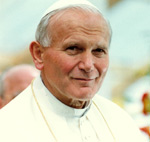
Born
in Wadowice, Poland, Pope John Paul II was one of our most
extraordinarily dedicated popes, and one especially loved by Polish
Catholics for what he did for his countrymen. Exploration of some of
the hidden mysteries of his genogram may help us understand his
spiritual dedication and his contribution to the collapse of
communism in Eastern Europe during his reign as Pope. Examining
genograms for the often overlooked legacies of untimely loss, and
cultural dynamics that intersect with family history may help us to
understand a person's role and character. In Pope John Paul's case,
untimely losses traumatized his family for at least two generations,
including the loss of both of his siblings, and his parents' early
loss of both of their mothers and several siblings.
John Paul's mother, Emilia Kaczorowski, lost her own mother when she
was 13 years old. From that time on she shared in the care of her
siblings, four of whom died before reaching the age of 30. It
appears that these early losses shaped her psyche, as she was
afterward said to be of "delicate health," "melancholy" temperament,
and "very religious" (a common outcome of being faced with the
mystery of death at such an early age).
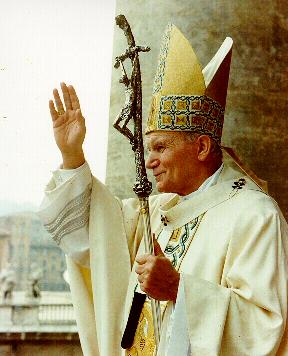
One
of the aspects of genograms we look at most closely is how the
mysteries of one person's genogram intersect with the mysteries in
the genogram of the partner they choose to marry. As a young adult,
Emilia met Karol Wojtyla, a pious and serious Lieutenant in the
Polish Army, while lighting candles and praying in their local
church; their spiritual connection was present from the start. She
was apparently drawn to his steady character, seriousness,
self-discipline, and strength. But perhaps at a deeper level their
connection was forged on a common history of pain and loss. Karol
too had experienced the tragic loss of his mother when he was just
three years old, and his own father would later die when their son
was only three years old.
Emilia and Karol were married in 1904. Surely they hoped they were
leaving their history of tragic loss behind them as they bore a
beautiful, healthy, and delightful son, Edmund, in 1906. He was
"bright, handsome, athletic, even-tempered, and helpful." (Bernstein
& Politi, p19).
They had no more children as far as is known until 1914 when a
daughter was born, whom they was named Olga, after Emilia's favorite
sister who had died at age 22. Here is one of the most intriguing
aspects of exploring the mysteries of genograms. We always look for
gaps in information to help us raise questions about what
information might be missing. Missing information often relates to
traumas that people try to leave out of their stories. When looking
at this family's genogram, we see that the couple had no other
children during that 10 year period, an uncommon pattern for this
time. Were there perhaps other pregnancies which resulted in
miscarriage, stillbirth or early childhood death? We do not know for
sure, but it seems likely that there were other pregnancies and
losses during those years. If so, how was the couple affected by
this series of untimely loss?
We do know that in 1914, the family was once again revisited by tragedy;
young Olga did not survive her first year. However, again there are
mysteries: we do not know how long she lived because no baptism certificate
or birth records were ever found, and she is not buried in the family tomb.
Why were there no records and why was she not buried with the rest of the
family? Such would certainly have been the religious custom. Could there
have been financial problems? Or was it because of the war since World War I
was going on at that time? Also, we may learn about mysteries of a family
from their naming patterns. We might wonder about the relationship between
Emilia and her sister Olga for whom she named her daughter, and about the
impact of having lost the daughter who shared such a connection with
Emilia's sister, Olga's namesake? Reportedly, Emilia's was said to have been
stricken by grief and her health declined even further from this point on.
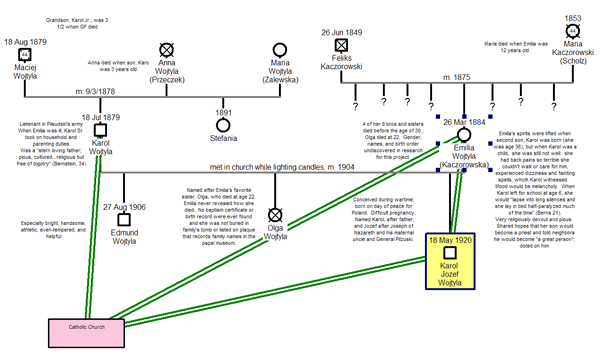 Genogram of the Pope John Paul II between 1920 and 1929
Genogram of the Pope John Paul II between 1920 and 1929
TThe children born following the death of a sibling often have special
significance in the family, so exploring the sibling patterns, particularly
around loss, is a major clue to unraveling family mysteries, as illustrated
by the sibling pattern of Karol Jozef Wojtyla, the future Pope John Paul II.
He was born May 18, 1920, just 6 years after years after his sister's death,
and significantly, his birth was on the very day when Poland was liberated
from the Soviet Union by Marshal Jozef Pilsudski. May 18, 1920, was "a day
of great significance for the Poles, a day called the Polish Miracle. On
that day, Marshal Jozef Pilsudski struck a deciding blow in the war against
the Soviet Union and seized Kiev. It was Poland's first major military
victory in over two centuries. It set in motion events which briefly
restored Poland's independence. Mindful of the nation's turning point,
Karol's father gave his new son Pilsudski's middle name. Some people said he
also called Karol "Josef" after Mary's self-sacrificing husband. The
confluence of history and religion were significant, as was the moment of
Karol's birth." (Barnes & Whitney, 1999).
The timing of Karol's birth was thus profoundly significant on two levels.
For the family it was a rebirth after a death, and for Poland it was a
national rebirth after two centuries of having been annihilated by
foreigners. It is for this reason that we always want to track cultural
history on a genogram and see where it intersects with family history, just
as we would want to note a baby born on Christmas or on the anniversary of a
national tragedy.
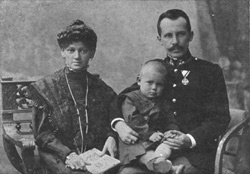
Emilia Kaczorowska and Karol Wojtyla
with their child Edmund
Karol Jr. was born at a pivotal moment in Polish history, which imbued his
life with hope and freedom, themes which seemed to stand in opposition to
the history of loss in his family. It was said that his birth brought his
mother's disposition back to life. She paraded him to neighbors saying that
he would be a very special man one day and she shared her wish that he would
eventually become a priest. Karol's early years occurred in an era of peace
and he received the utmost attention and adoration from his mother. She kept
him with her at all times, even when she visited doctors in neighboring
towns for her health; she shared with him her pious religious beliefs and
spiritual practices.
But tragedy struck again, just as it had for both parents in their
childhoods. At age 8, while Karol was away at school, Emilia suddenly died
of kidney and liver failure. The news shocked him into a withdrawn
melancholy, but deepened his bond with his father and his older brother,
Edmund, who was away studying medicine at Jagiellonian University. The
father became even more involved in the life of his sons. He wanted the best
for their education and future, and invested all his energy in their
spiritual and character development instilling in them self-discipline,
dedication, and a deep religious piety.
Karol Jr. forged a special connection with his brother, Edmund. He admired
and adored his successful and charming older brother and was thrilled to
attend Edmund's graduation from medical school. Once Edmund began medical
practice, Karol Jr. would volunteer to entertain Edmund's patients at the
hospital with his acting skills and creativity, getting to spend extra time
with his beloved brother.
But tragedy was not far away. Four years after the mother's death, on
December 5, 1932, Edmund died of Scarlet Fever, which he had contracted it
through his self-sacrificial caring for his patients. Karol was broken
hearted. He and his father, being the final survivors in the family, became
even more intensely connected, and when it was time for Karol to attend
Jagiellonian University in Krakow in 1938, his father moved with him to
Krakow so he could continue to support his only surviving child. One wonders
if this was something he had done with his own father after his own mother's
death or perhaps a connection he had wished to have.
Karol Sr. had instilled in his son a love of order and discipline, which
they cultivated in their mutual routine of prayer and study each morning,
meals together, shared walks in the evening, and discussion of ideas and the
day's learning prior to bed. After their devastating losses, they must have
hoped they would finally have a respite from their grief, but this would not
be so. The Nazi's closed the university in 1939, arresting many of the
faculty, and Karol had to support himself by various kinds of forced manual
labor. Then on February 18, 1941, Karol Sr. died suddenly of a heart attack
while his son was away from home. Karol was now alone in the world at age
21. He was even more devastated that once again he had not been with his
father when he died: "I wasn't there when my mother died; I wasn't there
when my brother died; and I wasn't there when my father died..." (Bernstein
& Politi, p51).
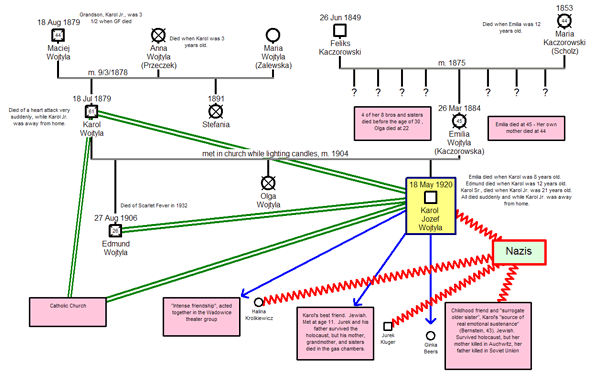 Genogram of the Pope John Paul II between 1929 and 1944
Genogram of the Pope John Paul II between 1929 and 1944
He had been majoring in drama, and had developed skills as an actor and grew
in his love of poetic and theatrical performance, so it was a great surprise
to his friends when he suddenly announced his intention to become a priest
the year after his father's death. Because of the Nazi takeover, he entered
an illegal, underground seminary to pursue his studies. Like his parents,
whose spirituality supported them following their early losses, he appears
to have found solace in his religious and social community, supported by
mentoring relationships by local priests and deep friendships with peers,
many of whom were Jewish and who had to flee during the Holocaust, in the
expanding trauma of his place and time. These losses too would mark him
forever, perhaps becoming the seeds of compassion and empathy for those who
suffer, which would influence his legacy as Pope years later.
Download the Genogram of Pope John Paul II -
GenoPro required

REFERENCES
Genograms
McGoldrick, M., Gerson, R., Petri, S.
Genograms, 3rd Edition
(in press, 2007), New York: W.W. Norton.
Pope John Paul II
Barnes, J., & Whitney, H. (1999).
John Paul II: His Life and
Papacy. PBS Frontline.
http://www.pbs.org/wgbh/pages/frontline/shows/pope/etc/bio.html
Bernstein, C., Politi, M. (1996).
His Holiness: John Paul II and the
Hidden History of Our Time.
New York: Doubleday.
Weigel, G. (2005).
Witness to Hope: The Biography of Pope John Paul II.
Harper Perennial.